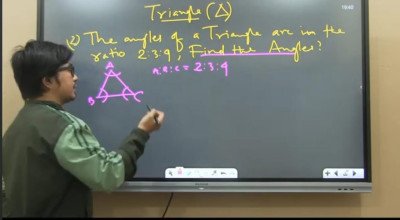Course description
Euclid's Geometry, often referred to as Euclidean geometry, is the study of geometric shapes and their properties based on the work of the ancient Greek mathematician Euclid. Euclid's Elements, composed around 300 BCE, is one of the most influential works in the history of mathematics, providing a comprehensive presentation of geometry as we know it today.
Here's a basic introduction to some key concepts in Euclid's Geometry:
Points, Lines, and Planes: Euclid starts with basic building blocks—points, which are location markers with no size; lines, which are straight paths extending indefinitely in both directions; and planes, which are flat surfaces extending infinitely in all directions.
Axioms and Postulates: Euclid establishes a set of axioms and postulates, which are self-evident truths or accepted assumptions. These serve as the foundation upon which all geometric reasoning is based. For example, one of Euclid's postulates is the "parallel postulate," which states that if a line crosses two other lines and the interior angles on one side are less than the sum of two right angles, then the two lines will eventually intersect on that side if extended far enough.
Definitions: Euclid provides precise definitions for key geometric terms, such as points, lines, angles, circles, polygons, etc. These definitions are crucial for understanding the properties and relationships of geometric objects.
Propositions: Euclid's Elements consists of a series of propositions, which are statements that are proven using logical reasoning based on the axioms, postulates, and previously proven propositions. These propositions cover a wide range of topics, including congruence, similarity, area, volume, and more.
Theorems and Corollaries: Through logical deduction, Euclid proves various theorems, which are important results derived from the axioms and postulates. Corollaries are additional statements that follow directly from previously proven theorems.
Construction: Euclid also includes methods for constructing geometric figures using a straightedge and compass, such as bisecting angles, drawing perpendicular lines, and constructing regular polygons.
Euclid's work laid the groundwork for centuries of mathematical exploration and remains influential in the study of geometry and its applications in fields such as architecture, engineering, and physics.
ইউক্লিডের জ্যামিতি, প্রায়শই ইউক্লিডীয় জ্যামিতি হিসাবে উল্লেখ করা হয়, প্রাচীন গ্রীক গণিতবিদ ইউক্লিডের কাজের উপর ভিত্তি করে জ্যামিতিক আকার এবং তাদের বৈশিষ্ট্যগুলির অধ্যয়ন। প্রায় 300 খ্রিস্টপূর্বাব্দে রচিত ইউক্লিডস এলিমেন্টস গণিতের ইতিহাসে সবচেয়ে প্রভাবশালী কাজগুলির মধ্যে একটি, যা আজকে আমরা জানি জ্যামিতির একটি ব্যাপক উপস্থাপনা প্রদান করে।
এখানে ইউক্লিডের জ্যামিতির কিছু মূল ধারণার একটি প্রাথমিক ভূমিকা রয়েছে:
বিন্দু, রেখা এবং সমতল: ইউক্লিড মৌলিক বিল্ডিং ব্লক দিয়ে শুরু হয়—বিন্দু, যেগুলো অবস্থান চিহ্নিতকারী যার কোনো আকার নেই; লাইন, যা উভয় দিকে অনির্দিষ্টকালের জন্য প্রসারিত সরল পথ; এবং প্লেনগুলি, যা সমতল পৃষ্ঠগুলি সমস্ত দিকে অসীমভাবে প্রসারিত।
স্বতঃসিদ্ধ এবং অনুমান: ইউক্লিড স্বতঃসিদ্ধ এবং অনুমানগুলির একটি সেট স্থাপন করে, যা স্বতঃসিদ্ধ সত্য বা গৃহীত অনুমান। এগুলি ভিত্তি হিসাবে কাজ করে যার উপর সমস্ত জ্যামিতিক যুক্তি নির্ভর করে। উদাহরণ স্বরূপ, ইউক্লিডের অনুমানগুলির মধ্যে একটি হল "সমান্তরাল পোস্টুলেট", যা বলে যে যদি একটি রেখা অন্য দুটি রেখাকে অতিক্রম করে এবং এক পাশের অভ্যন্তরীণ কোণ দুটি সমকোণের সমষ্টির চেয়ে কম হয়, তাহলে দুটি রেখা শেষ পর্যন্ত তার উপর ছেদ করবে। পাশ যদি যথেষ্ট প্রসারিত হয়।
সংজ্ঞা: ইউক্লিড মূল জ্যামিতিক পদগুলির জন্য সুনির্দিষ্ট সংজ্ঞা প্রদান করে, যেমন বিন্দু, রেখা, কোণ, বৃত্ত, বহুভুজ ইত্যাদি। জ্যামিতিক বস্তুর বৈশিষ্ট্য এবং সম্পর্ক বোঝার জন্য এই সংজ্ঞাগুলি অত্যন্ত গুরুত্বপূর্ণ।
প্রস্তাবনা: ইউক্লিডের উপাদানগুলি প্রস্তাবনার একটি সিরিজ নিয়ে গঠিত, যা এমন বিবৃতি যা স্বতঃসিদ্ধ, অনুমান, এবং পূর্বে প্রমাণিত প্রস্তাবগুলির উপর ভিত্তি করে যৌক্তিক যুক্তি ব্যবহার করে প্রমাণিত হয়। এই প্রস্তাবনাগুলি বিস্তৃত বিষয়গুলিকে কভার করে, যার মধ্যে সামঞ্জস্য, সাদৃশ্য, ক্ষেত্রফল, আয়তন এবং আরও অনেক কিছু রয়েছে৷
উপপাদ্য এবং উপপাদ্য: যৌক্তিক ডিডিকশনের মাধ্যমে, ইউক্লিড বিভিন্ন উপপাদ্য প্রমাণ করে, যেগুলো স্বতঃসিদ্ধ এবং অনুমান থেকে প্রাপ্ত গুরুত্বপূর্ণ ফলাফল। কোরোলারী হল অতিরিক্ত বিবৃতি যা পূর্বে প্রমাণিত উপপাদ্য থেকে সরাসরি অনুসরণ করে।
নির্মাণ: ইউক্লিড একটি সরল প্রান্ত এবং কম্পাস ব্যবহার করে জ্যামিতিক চিত্র নির্মাণের পদ্ধতিও অন্তর্ভুক্ত করে, যেমন দ্বিখণ্ডিত কোণ, লম্ব রেখা আঁকা এবং নিয়মিত বহুভুজ নির্মাণ।
ইউক্লিডের কাজ শতবর্ষের গাণিতিক অন্বেষণের ভিত্তি স্থাপন করেছিল এবং জ্যামিতি অধ্যয়ন এবং স্থাপত্য, প্রকৌশল এবং পদার্থবিদ্যার মতো ক্ষেত্রে এর প্রয়োগগুলিতে প্রভাবশালী রয়েছে।



















